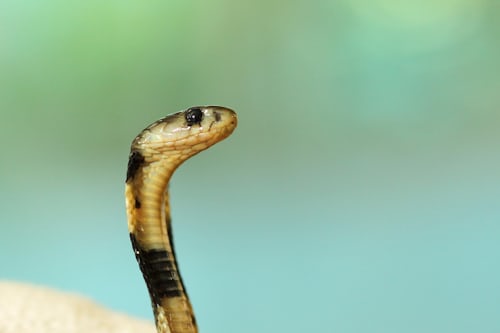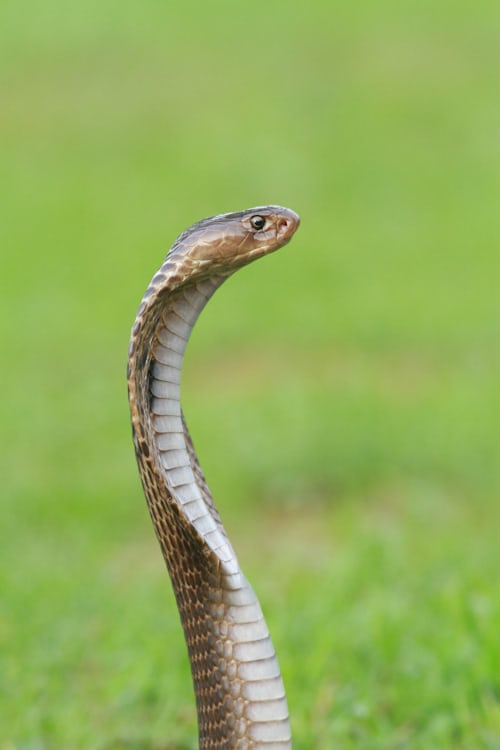
King Cobra
King Cobra
The king cobra (Ophiophagus hannah) is a venomous snake that is found in South and Southeast Asia. It is the longest venomous snake in the world, with some individuals growing up to 18 feet (5.5 meters) in length.
King cobras have a distinctive appearance, with a hood that can be expanded when the snake is threatened or agitated. They are usually a brown or olive color, with dark brown or black bands running along the length of their body. Their venom is highly toxic and can cause respiratory failure or cardiac arrest in humans.
King cobras are known for their aggressive behavior and will not hesitate to attack if they feel threatened. They are also known to be highly intelligent and have been observed using tools in the wild, such as using twigs to probe for prey hiding in small crevices.
Despite their fearsome reputation, king cobras play an important role in their ecosystem as top predators, helping to control the populations of smaller animals such as rodents and other snakes.
Here is the taxonomic classification of the king cobra:
King cobras belong to the family Elapidae, which includes other venomous snakes such as the taipan, mamba, and coral snake. Their scientific name is Ophiophagus hannah, with the genus name "Ophiophagus" meaning "snake-eater" and the species name "hannah" referring to a mythological snake from India.
- Kingdom: Animalia
- Phylum: Chordata
- Class: Reptilia
- Order: Squamata
- Suborder: Serpentes
- Family: Elapidae
- Genus: Ophiophagus
- Species: Ophiophagus hannah
So, the king cobra's full scientific name is Ophiophagus hannah.
Here are some of the key characteristics of the king cobra:
-
Size: King cobras are the longest venomous snake in the world, with some individuals growing up to 18 feet (5.5 meters) in length, although the average length is around 10-13 feet (3-4 meters).
-
Appearance: King cobras have a distinctive appearance, with a hood that can be expanded when the snake is threatened or agitated. They are usually a brown or olive color, with dark brown or black bands running along the length of their body. Their head is large and flattened, with two small, fixed fangs at the front of their mouth.
Behavior
Here are some of the key behaviors of this species:
The behavior of the king cobra is fascinating and unique among snakes.
Aggressiveness: King cobras are known for their aggressive behavior, and will not hesitate to attack if they feel threatened or cornered. They can move quickly and strike with great accuracy, and their venom is highly toxic.
Intelligence: King cobras are highly intelligent and have been observed using tools in the wild, such as using twigs to probe for prey hiding in small crevices. They are also capable of problem-solving and have shown the ability to learn and remember.
Communication: King cobras use a variety of signals to communicate with each other, including hissing, growling, and hooding. They can also detect chemical signals left by other snakes, allowing them to locate potential mates or rivals.
Here are some of the key aspects of the king cobra's diet:
The king cobra is primarily a carnivorous species, meaning it feeds on other animals.
-
King cobras are known to be cannibalistic and will sometimes feed on other snakes, including other venomous species like cobras and vipers. They are also known to feed on non-venomous snakes.
-
Small mammals: King cobras also prey on small mammals such as rodents, which they can subdue with their venomous bite. They have been observed feeding on rats, mice, and other small animals.
-
Birds: King cobras will occasionally feed on birds, including chicks and eggs that they can find in nests.
-
Lizards: King cobras are known to eat a variety of lizards, including skinks, geckos, and agamids.
-
Amphibians: King cobras have been observed feeding on amphibians such as frogs and toads, which they can catch near water sources.
Habitat
Here are some of the key details about its habitat:
The king cobra is a highly adaptable species that can be found in a variety of habitats across Southeast Asia and parts of the Indian subcontinent.
1. Forests: King cobras are commonly found in forested areas, including both tropical and deciduous forests. They are often found near water sources, such as rivers and streams, and are able to climb trees to hunt for prey.
2. Grasslands: King cobras are also found in grasslands and savannas, particularly those with tall grasses that provide cover for hunting and protection from predators.
3. Wetlands: King cobras are known to inhabit wetlands such as swamps and marshes, where they can find a variety of prey including fish, frogs, and other amphibians.
4. Agricultural areas: King cobras are also found in agricultural areas such as rice paddies, where they can find a variety of prey including rodents and lizards.
Overall, the king cobra is a versatile species that can thrive in a variety of habitats, as long as it has access to water and prey. However, habitat loss and fragmentation are major threats to this species, and conservation efforts are needed to ensure their survival in the wild.
How Venomous is the king cobra?
The king cobra (Ophiophagus hannah) is considered one of the most venomous snakes in the world. Its venom is extremely potent, and a single bite can deliver enough venom to kill an adult elephant.
The venom of the king cobra primarily targets the nervous system, causing paralysis and respiratory failure in its prey. In humans, a king cobra bite can cause severe pain, swelling, and tissue damage, as well as neurological symptoms such as dizziness, blurred vision, and even coma. Without proper treatment, a king cobra bite can be fatal.
However, it's worth noting that king cobras are generally not aggressive towards humans, and will usually try to escape rather than attack. Most bites occur when people accidentally step on or disturb a king cobra, or when they attempt to handle or capture the snake. As with any venomous snake, it's important to exercise caution and respect when in the presence of king cobras, and to seek medical attention immediately in the event of a bite.
Population and Conservation Status
The population size of king cobras is not well-known, but they are generally considered to be a species of least concern by the International Union for Conservation of Nature (IUCN). However, they are threatened by habitat loss and hunting for their skins and other body parts.
King cobras are protected by law in many countries throughout their range, and they are listed under Appendix II of the Convention on International Trade in Endangered Species of Wild Fauna and Flora (CITES), which regulates international trade in their skins and other products. In some areas, conservation efforts are underway to protect king cobra populations and their habitats, including the creation of protected areas and education programs to reduce human-snake conflict.
Overall, while the king cobra is not currently considered a species at immediate risk of extinction, continued habitat destruction and hunting could threaten their populations in the future. Conservation efforts are needed to ensure their survival in the wild.
King Cobra in Popular Culture
The king cobra is a highly venomous snake found in Southeast Asia and parts of the Indian subcontinent, and it has been featured in various forms of popular culture over the years. Here are some examples:
-
Movies: The king cobra has been featured in several movies, including the 2007 film "Live Free or Die Hard", where it is used as a weapon by the main villain. It is also featured in the 2010 movie "The Karate Kid", where it is used as a symbol of the protagonist's fears.
-
Video games: The king cobra has appeared in several video games, including "Far Cry 4", where it is one of the many dangerous creatures that players must avoid or defeat.
-
Literature: The king cobra has been featured in various books and novels, including the famous novel "The Jungle Book" by Rudyard Kipling, where it is personified as the character Kaa.
-
Culture: In India, the king cobra is revered as a powerful and mystical creature, and it features prominently in many myths and legends. It is also associated with various deities, including Lord Shiva.
-
The king cobra has become a symbol of danger, power, and mystery in popular culture, and it continues to fascinate and inspire people around the world. However, it's important to remember that these snakes are wild animals and should be respected and left alone in their natural habitats.
Can a human survive a king cobra bite?
Survival from a king cobra (Ophiophagus hannah) bite depends on several factors, including the amount of venom injected, the location of the bite, the age and health of the victim, and the speed and effectiveness of medical treatment.
King cobra venom is highly toxic and can cause severe symptoms, including paralysis, respiratory failure, and cardiac arrest. Without prompt and appropriate medical treatment, a bite from a king cobra can be fatal, even for a healthy adult.
However, with quick administration of antivenom and supportive care, many victims can survive a king cobra bite. The antivenom is the only specific treatment for king cobra venom, and it works by binding to the venom molecules and neutralizing their effects. In addition to antivenom, supportive care may include respiratory assistance, fluid and electrolyte replacement, and management of complications.
It's worth noting that king cobras are generally not aggressive towards humans and will usually try to escape rather than attack. Most bites occur when people accidentally step on or disturb a king cobra, or when they attempt to handle or capture the snake. As with any venomous snake, it's important to exercise caution and respect when in the presence of king cobras, and to seek medical attention immediately in the event of a bite.
Are King Cobra Aggressive?
King cobras (Ophiophagus hannah) are generally not aggressive towards humans and will typically try to avoid confrontation and escape if given the opportunity. However, like all animals, they can become defensive and potentially dangerous if they feel threatened or cornered.
King cobras are known for their impressive size and deadly venom, which makes them a potential danger to humans who come into contact with them. They are also known for their unique behavior of rearing up and spreading their hoods, which can make them appear more intimidating and aggressive than they actually are.
It's important to remember that king cobras are wild animals and should be respected and left alone in their natural habitats. If you encounter a king cobra in the wild, it's best to give it a wide berth and not to attempt to handle or approach it. If you must interact with a king cobra for any reason, it should only be done by trained professionals with the appropriate equipment and safety precautions in place.
What happens if you’re bitten by a King Cobra?
If you are bitten by a king cobra (Ophiophagus hannah), it is a medical emergency and you should seek immediate medical attention. King cobra venom is highly toxic and can cause severe symptoms, including paralysis, respiratory failure, and cardiac arrest.
Symptoms of a king cobra bite can include:
- Severe pain at the site of the bite
- Swelling and discoloration around the bite area
- Nausea and vomiting
- Dizziness and weakness
- Blurred vision
- Difficulty breathing
- Respiratory failure
- Cardiac arrest
If you are bitten by a king cobra, it is important to remain as calm as possible and seek medical attention immediately. Do not try to suck out the venom or cut the wound, as this can cause further damage and delay proper medical treatment. Keep the affected limb immobilized and at or below the level of your heart, and remove any tight clothing or jewelry from the affected area.
Treatment for a king cobra bite typically involves administration of antivenom, which is the only specific treatment for king cobra venom. In addition to antivenom, supportive care may include respiratory assistance, fluid and electrolyte replacement, and management of complications. The earlier treatment is started, the better the chances for survival and minimizing potential long-term effects of the venom.
Here are some fun facts about king cobras:
1. King cobras are the longest venomous snakes in the world, reaching lengths of up to 18 feet (5.5 meters).
2. Despite their name, king cobras are not true cobras and are instead the only species in the genus Ophiophagus, which means "snake-eater" in Greek.
3. King cobras are found throughout Southeast Asia and parts of India, and are known for their iconic appearance and behavior of rearing up and spreading their hoods when threatened.
4. King cobras are not aggressive towards humans and will typically try to avoid confrontation and escape if given the opportunity. However, they can become defensive and potentially dangerous if they feel threatened or cornered.
5. King cobra venom is highly toxic and can cause severe symptoms, including paralysis, respiratory failure, and cardiac arrest. However, with prompt and appropriate medical treatment, many victims can survive a king cobra bite.
6. In the wild, king cobras primarily eat other snakes, including venomous snakes like vipers and other cobras.
7. King cobras are important cultural symbols in many parts of their range and are often depicted in folklore, mythology, and popular culture.
8. The king cobra has been known to be kept as a pet by some people, but this is illegal in many countries due to their venomous nature and the risk they pose to humans
Blog Upload on - April 19, 2023
Views - 2480















